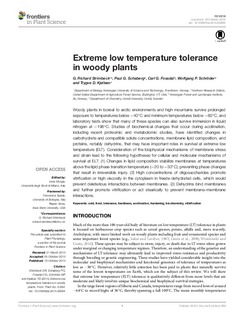| dc.contributor.author | Strimbeck, Richard | |
| dc.contributor.author | Schaberg, Paul G. | |
| dc.contributor.author | Fossdal, Carl Gunnar | |
| dc.contributor.author | Schröder, Wolfgang | |
| dc.contributor.author | Kjellsen, Trygve Devold | |
| dc.date.accessioned | 2016-03-02T14:17:29Z | |
| dc.date.accessioned | 2016-04-06T08:59:36Z | |
| dc.date.available | 2016-03-02T14:17:29Z | |
| dc.date.available | 2016-04-06T08:59:36Z | |
| dc.date.issued | 2015 | |
| dc.identifier.citation | Frontiers in Plant Science 2015, 6 | nb_NO |
| dc.identifier.issn | 1664-462X | |
| dc.identifier.uri | http://hdl.handle.net/11250/2384210 | |
| dc.description.abstract | Woody plants in boreal to arctic environments and high mountains survive prolonged exposure to temperatures below -40°C and minimum temperatures below -60°C, and laboratory tests show that many of these species can also survive immersion in liquid nitrogen at -196°C. Studies of biochemical changes that occur during acclimation, including recent proteomic and metabolomic studies, have identified changes in carbohydrate and compatible solute concentrations, membrane lipid composition, and proteins, notably dehydrins, that may have important roles in survival at extreme low temperature (ELT). Consideration of the biophysical mechanisms of membrane stress and strain lead to the following hypotheses for cellular and molecular mechanisms of survival at ELT: (1) Changes in lipid composition stabilize membranes at temperatures above the lipid phase transition temperature (-20 to -30°C), preventing phase changes that result in irreversible injury. (2) High concentrations of oligosaccharides promote vitrification or high viscosity in the cytoplasm in freeze-dehydrated cells, which would prevent deleterious interactions between membranes. (3) Dehydrins bind membranes and further promote vitrification or act stearically to prevent membrane–membrane interactions. | nb_NO |
| dc.language.iso | eng | nb_NO |
| dc.publisher | Frontiers Media | nb_NO |
| dc.title | Extreme low temperature tolerance in woody plants | nb_NO |
| dc.type | Journal article | nb_NO |
| dc.type | Peer reviewed | nb_NO |
| dc.date.updated | 2016-03-02T14:17:29Z | |
| dc.source.volume | 6 | nb_NO |
| dc.source.journal | Frontiers in Plant Science | nb_NO |
| dc.identifier.doi | 10.3389/fpls.2015.00884 | |
| dc.identifier.cristin | 1281670 | |
| dc.relation.project | NIBIO - Norsk institutt for bioøkonomi: 221479 | nb_NO |
| dc.description.localcode | © 2015 Strimbeck, Schaberg, Fossdal, Schröder and Kjellsen. This is an open-access article distributed under the terms of the Creative Commons Attribution License (CC BY). The use, distribution or reproduction in other forums is permitted, provided the original author(s) or licensor are credited and that the original publication in this journal is cited, in accordance with accepted academic practice. No use, distribution or reproduction is permitted which does not comply with these terms. | nb_NO |
